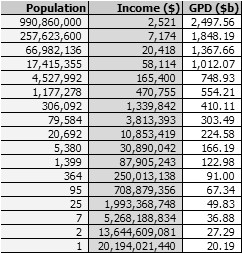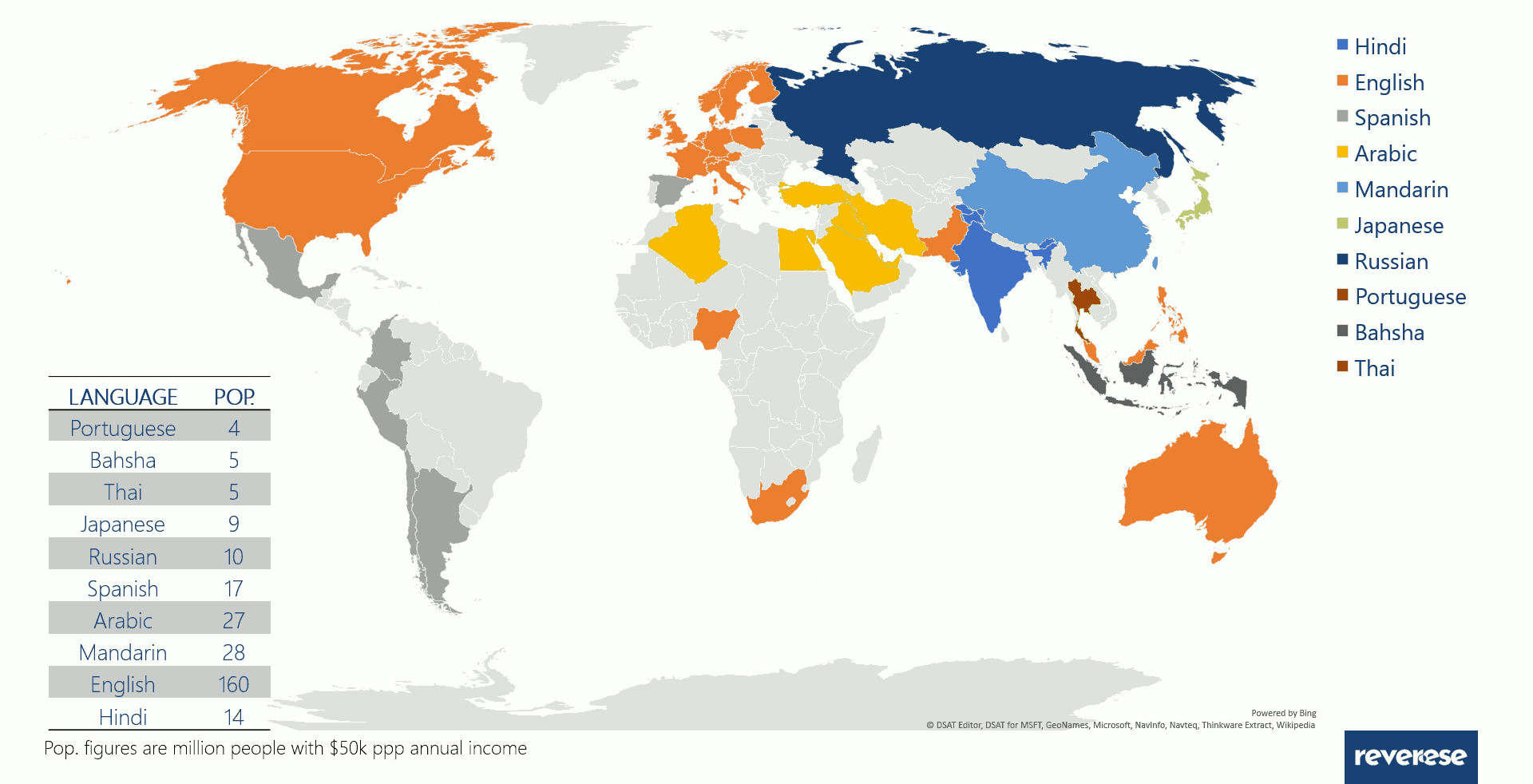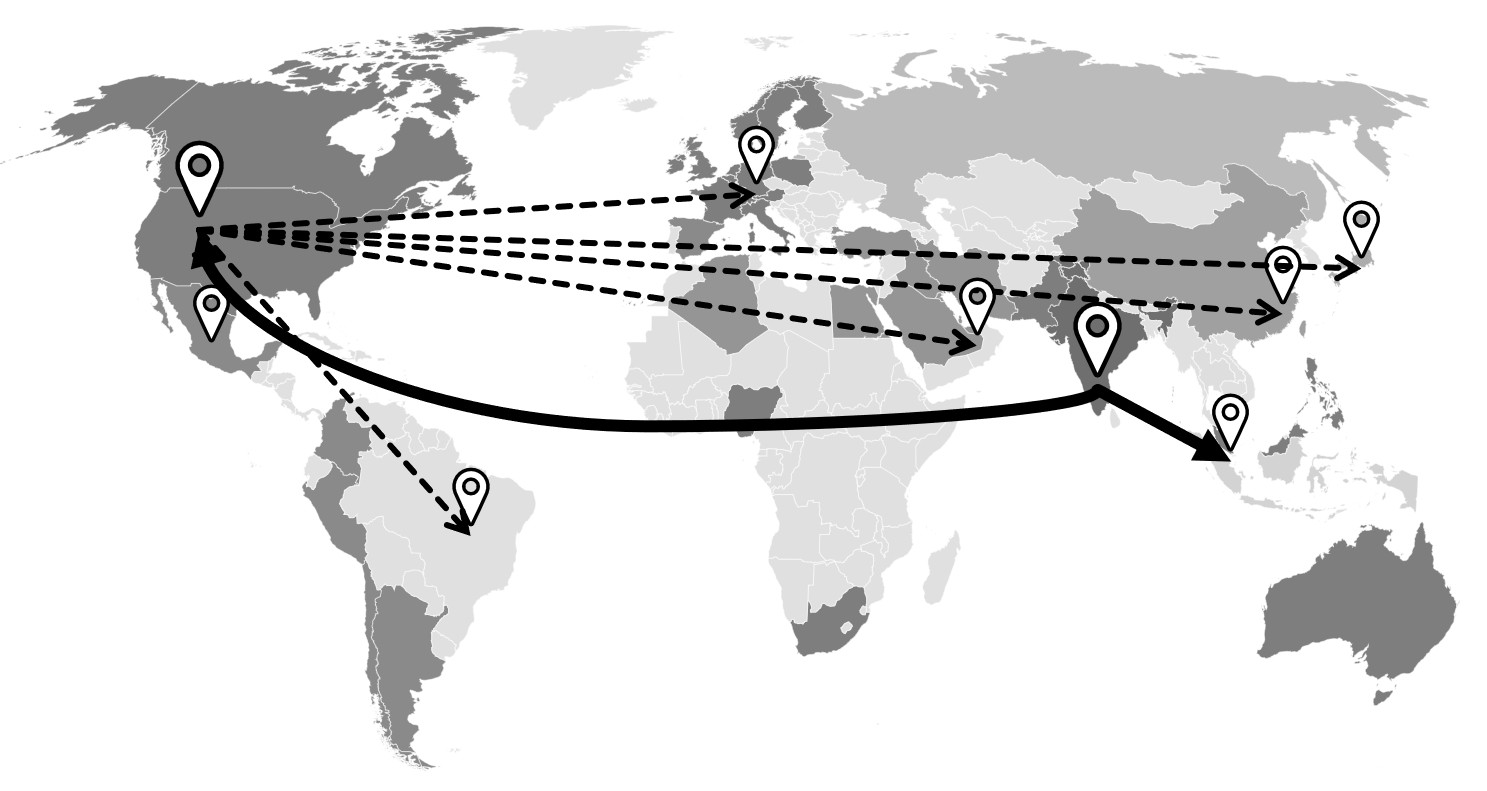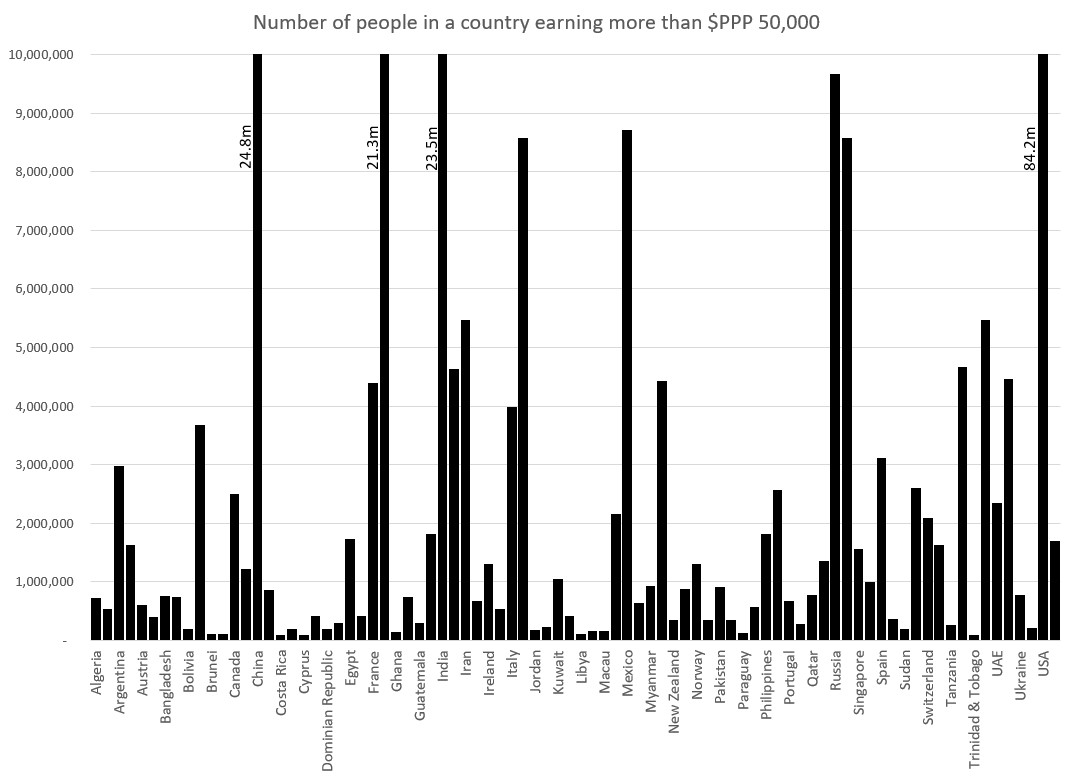It’s a shame, Indian startups aren’t going international

Image curtsy PixaBay
We are the only multicultural country of significant size. Most other countries are tiny when compared to the size of our market. Just 10 languages can give you more than 50% global coverage. What we need are the mindset and an ecosystem.
Note: This article is based on an analysis that I did for Reverease. Parameters I used in the analysis are tuned to suit my own case. Your mileage will vary.
Edit (Jul 19): I did this analysis in 2017. Back then, there was hardly any news about building an Indian startup for the international market. If I had a dollar for every time I was told that I should wise up and focus in India (India is a big market, blah, blah), I could have put together my seed money. In the last two years, things have changed dramatically. Oyo conquered China and Ola started talking international. Building for the international market out of India is not an oddity anymore. I am glad that things are changing for the better. This analysis has better utility value now than it had in 2017.
The Analysis
I took all the countries in the world, tabulated their population and corresponding per-capita income in $PPP terms. I left out a few countries because they do not have latest income statistics (e.g. Syria, Palestine). Few countries have tiny population (e.g. Belize has smaller population than Karol Bagh). Few more countries or so poor (e.g. Congo’s $PPP is about one tenth of India’s), it doesn’t justify putting your efforts.
That left me with just 85 countries, down from a total of 195. These 85 countries have about 6.5b people living in them. So, we didn’t miss much.
Pareto Principle
Next, I had to figure out how many people in these countries can afford our services. My gut feeling was that my customer in India would be earning about ₹1m per year or more. Which is equal to about $PPP 50k. I had to figure out how many people in these countries earned more than $PPP 50k.
To do that, I applied Pareto Principle (80/20 rule) on the total population and graded them into various income brackets. I took it that in any population, 20% of the people earned 80% of the income. Based on the results I saw (not getting into the details here), I felt that 74/26 would be a better split than 80/20. So I went with it. Remember, I only want a very approximate solution, just to give me a sense of direction. When the time comes for implementation, I can rework the numbers with real data.
Let me show you how this works with India’s data (incomes are in $PPP).
- India’s population: 1,339m
- India’s per-capita income: $7,174
- India’s GDP: 1,339m x 7,174 = $9.6t
- Since we are assuming that 74% of the population makes 26% of the GPD
- The bottom 74% of India (990m) must be making (26%*$9,6t=) $2.5t
- Per-capita of bottom 74% = 2.5t/(0.74*1.339) = $2,521
- Let’s call them Level-1
- They were not in my target segment. Not till I have a product for them
- That left me with (1,339-990=) 339m people, earning ($9.6t-$2.5t=) $7.1t
- When I applied 74/26 rule on this, the bottom 74% (of top 26%) fell into $7,174 income bracket
- This Level-2 was still not in my bracket
- How about bottom 74% of top 26% of top 26%? Sorry…this is so Inception like!
- 67m people in Level 3 each $20k $PPP per year. Next.
- Level 4: 17m people, with $58k annual income each (this is in my bracket)
- Level 5: 4.5m people, with $165k annual income each
- Level 6: 1.2m people, with $470k/a
- Level 7: 300k people, $1.3m/a
- Level 8: 80k people, $3.8m/a
- Level 9: 20k people, $11m/a
- Level 10: 5k people, $31m/a
- Level 11: 1,400 people, $90m/a
- Level 12: 350 people, $250m/a
- Level 13: 100 people, $700m/a
- Level 14: 25 people, $2b/a
- Level 15: 7 people, $5b/a
- Level 16: 2, $13b/a
- Level 17: 1, $20b/a
Before you shoot me down because no one in India is making $20b/a (are you sure?), remember that these incomes are in $PPP. You must divide these income by 3.6 to get the actual dollars. Besides, I am only trying to get an approximate fix.
Here are the calculations we just did, neatly packed in a table:

I repeated this for each of the 85 countries in the list (hail Excel) and aggregated people in different $PPP income brackets. This chart, for example, shows the number of people in each country, who earn $PPP 50k or more per year.
Four countries have more than 10m people who earn more than $PPP 50k/a . They are US (82m ), China (25m), India (23m) and Germany (21m). From this list of 85 nations, I eliminated the countries that have less than a million people earning $PPP 50k or more (that, I felt, was the critical population for me). One decent sized Indian state, for example, has more than a million $PPP 50k eaerners.
That left me with the following 42 countries. I don’t have to worry about the rest of (195-42=) 153 countries for now. I can get into them, if at all, from one of these 42 out posts (e.g. Sri Lanka and Bangladesh are almost like another state of India).

The Inferences
Taking a closer look at these 42 countries yielded some interesting insights. Some insights turned out to be completely unexpected.
Who matters
For me, with my cut-off criteria (that a country must have about a million people earning $PPP 50k or more), only 42 countries in the world really matter. Rest don’t have sufficient “Money, multiplied by People” to build a decent scale.
Four countries in the world (my world, for the time being, is made up of just those 42 countries) have more than half my prospective customers!

To me, Germany was a surprise entrant into the list. With its tiny population, I didn’t expect it to be in the league table. But its per-capita income is so high that its average percapita happens to be more than $PPP 50k!
If you are an Indian company, based on these numbers alone, US is the best choice for first stop for you. Germany is the second (because it gives you access to rest of Europe). China, the third. But then, I ended up changing this order of priority for reasons I’ll explain shortly.
By the way, all of these are fiercely competitive markets. Building the management depth to take on these markets is a critical thing. Which is the single largest problem Indian companies will have to solve, if they are ever going to become sea faring.
Africa hardly matters
These are the most affluent African countries. I made a chart showing the number of 50+k earners in each of these countries and compared them with Indian number.

In all, there are only some 4.3m qualified customers among these countries. All of them put together are worth just one fifth of India’s market size. If you scroll down and take a look at the map under the “Language Split” section, you will notice:
- Egypt and Algeria speak Arabic. You are better off to manage them as part of Arabic nations.
- Nigeria is in a Western corner of Africa and South Africa is the southern corner. They are perfect beach heads for the corresponding regions in Africa. But that is for the future. Today, they are so tiny markets, and they are so scattered, you don’t have to go there in a hurry.
South America is tiny too
South America is only little better than Africa: South America’s qualified countries are:

With total $PPP 50k earners of 7m, South America is only 1/3rd of India. Brazil is the only country that has decent size of market. Brazil speaks Portuguese, where rest of the South American countries speak Spanish. So, South America is actually two sub-continents. You will need one team to manage Brazil, and another to manage the rest of the countries. Each of these two blocks smaller than any major European country.
Other Tiny Tots
These countries are so small, usually as big as one decent sized state of India, I can’t help wondering how they managed to get themselves placed above India (and in case of Pakistan, along with India)! Judge for yourself.

Singapore and Malaysia, I would say, have climbed down from the high perch they used to sit during the 90s. But Australia, with less than 10% of India’s might, pulls more punch in most international fora. HTF!
And Pakistan. It is bloody hilarious that once up on a time they thought themselves as serious economic competition to us! By the way, do you know what is Bangladesh’s number? 750k, against Pakistan’s 900k. Can you guess if Tamil Nadu were a separate country, what would be its number? 1.2m! That we treat these guys as if they are in our same league is a bloody joke!
Europe
Germany is the powerhouse of Europe. The country has almost as many number of 50k earners as India or China (21m , 24m and 28m, respectively). UK and France, in comparison, pale (4m each). If you want to compare them at all, it should be with Brazil. Not India.
More than 70% of educated people in Germany speak English. And their management talent, their penchant for perfection, and their attention to details, are all legendary. Making Germany the European hub is a great idea for many reasons.
But there is only one good reason to make UK the European hub (which is what most Indian companies do): You will always find an Indian bloke, who will provide you easy early-access to the market. That is a short term advantage.
Others worth mentioning
Here are few countries that are worth mentioning:
- Japan (9m)
- Russia (10m)
- Indonesia (5m)
- Thailand (5m)
Of these, you should take a close look at Indonesia. Many businesses in this country is managed by expat CXOs, and people respect Indians for their competence (Oman is the other country that I know of). The Government is chaotic, but competition is not as fierce as India.
Thailand is worthy candidate too. That is because the people are so beautiful on the inside. If you are going to have presence in only one country outside India, make it India and Thailand! You can make money in India, and settle in Thailand after you had your exit. Just kidding!
Many Indian doctors have been graduating form Russia. If you are in healthcare, you have Russian speaking Indian work force waiting for you to take you there.
Japan, to my mind, is an odd man out. It has tough competition, culturally distant, has its own language…Japan doesn’t appeal to my gut senses. I must perhaps catch hold of someone from Zoho, sit them down and have a talk. Zoho has been making big money in Japan. Or I should talk to Rajinikanth (he is famous in Japan).
Language Split
Before we go on to the next topic, let’s see what languages these countries speak.
- English (many countries): 150m
- Mandarin: 28m
- Arabic: 27m
- Hindi: 23m
- Germany: 21m
- Spanish: 17m
- Russian: 10m
- Japanese: 8m
- Bahsha Indonesia: 5m
- Thai: 5m
- Portuguese: 4m
Let’s do a pie chart:

If you are from India, your managers understand the languages spoken by 2/3rd of the this population (English + Hindi + English spoken in Germany).
Next, let’s look at these countries in a map.

Among English countries, only US, India and Germany have sufficiently large population. Others have tiny markets (4m or smaller). They are not going to produce an Alibaba or Flipcart, any time soon (implications: global scale investors don’t have many choices). Forget competition from countries like UK, France, Australia, New Zealand, Singapore or Israel . They can never amass the size of an Indian company can. Even to amass size in a pure demat play (e.g. Google, Facebook), you will need sufficiently large number of deep tech talent. Nope. None of them can pull it through. If you don’t relate to what I am talking here, you should spend 20 minutes of your life, watching this TED talk by Matt Ridley, one of my heroes.
Arabia, what is happening to you!?
I am surprised that startups from the Arabic speaking region are not in the radar already. May be it is because the population is made up of many disparate countries. India and China, on the other hand, have giant market within a single border. For an Indian startup, I think your first non-English/non-Indian teams must be Arabic. We have an excellent cultural fit, it’s a familiar market, strong Indian diaspora is already all over the Arabic region and the competition is much easier than it is in China.
If you have the guts, you should enter China too. It is too large a homogeneous piece juicy treat, just sitting there, waiting for you to grab and put it in your mouth. Just be sure that it is not going to explode in your mouth.
Germany. I don’t understand Germany: How come a market this large (21m) never produced anything global scale!? Even tiny France (4m) has Blah Blah Car.
Hindi: It is a stupidity that Indian startups are not localizing. But hey, there is no hurry. Take your sweet time. I don’t want you all to wake up till I walk over in an year or so, and start picking out all low hanging fruits.
What did Bezos do?
It is always nice to test your theories with some data, right? I chose to see what Amazon did. Why Amazon? Because Amazon is not a demat play like Facebook or Google. Even for Apple, every country other than US is just a market. They all sit in the Silicon Valley and take money out of global wallets (what a life!). Amazon is the only digital company that must smell the countries where it is present.
Here is the list of English websites Amazon has. All, except India, are Caucasian markets:
- US (84m)
- India (24m)
- Germany (21m) <- Wow
- UK (4m)
- Canada (3m)
- Australia (2m)
- Ireland (1m)
Here is the list of non-English Amazon websites, but culturally very close to American organizations (Caucasians and next door neighbor)
- Mexico (9m)
- France (4m)
- Italy (4m)
- Netherlands (4m)
- Spain (3m)
Here is the list of all the culturally-distant countries Amazon is present:
- China (25m)
- Japan (9m)
- Brazil (4m)
I can understand why Amazon is not in Russia (10m). But it makes no sense why they are not in the Middle East (27m). Saudi Arabia alone is as big as Japan! All of Middle East put together is as large as India or China. The “white man is shit scared of the rag heads”, it seems.
When Amazon decided to expand, it looks to me, market size and cultural similarity were the factors that determined their expansion decision.
If other American startups are like Amazon, they are going to leave Middle East and Russia open for a long time to come. But Indians are inherently comfortable operating in the Middle East. That is one more reason why the first international stop-over for your startup my be in the Middle East. Secure the market before the Americans or the Chinese do. Arabia seem to be too strange for these people. At least for now.
Dual HQ business model
As I mentioned in the lead para, India is the only large country with multicultural work force. Other multi-cultural countries (e.g. UAE, Singapore) are just about one tenth the size of India. They can never understand scale. We are the only people who understand both scale and pluralism.
But India does not have global managers or global investors. You get them only in the US. If you are an Indian startup with global aspirations, I think you must evolve an unique dual-HQ model: India is where you lay the foundation, build the tech, test the markets, etc. But US is where you polish your tech and scale your business.
You will need regional hubs at Germany (Europe), UAE (Middle East), Singapore (Far East) and Spain/Mexico (for the Spanish block). China, Japan, Russia and Brasil must all be treated as independent regions. With the exception of Singapore, you are better off to manage all the regional hubs from your US HQ.

You will also be better off to deeply integrate the German managers with your “Indian team”, I think! The German thoroughness is needed to balance the Indian freewheeling. Though, remember to fit all your buildings with suicide nets.
Summary
- India is the only multi-cultural country that also has scale.
- An Indian organization won’t be running scared from places like the Middle East or Russia, like Amazon does.
- Given our low cost base, we can build global technology/business at a tiny fraction of what it costs in the US.
Unfortunately, we neither have the skill, nor have the ecosystem, to build a global organization. Most of all, we don’t have the mindset. Too many times I have been told it is imprudent to waste energy outside India.
It is true that Indian market is humongous that most other countries cannot hold a candle to it. But then, what do you do after you grow up to dominate the Indian market?
Sell off to a gringo?
That’s a shame!
Questions I am seeking answers for
Here are some questions that I would love to have answers for. If you have one, please leave a note in the comments section:
- Despite a large market, and very competent management, why hasn’t Germany produced an Amazon, Alibaba or even a Blah Blah car? Why there it hasn’t produced any companies of international scale! Not even a pure demat play. Even tiny Israel (which is not even in my 42 countries list) does better.
- How did Zoho manage to make inroads into Japan? Are there any other Indian companies that went into Japan successfully? What does it take to win over Japanese market, if you can put it briefly?
- How do you tame the dragon? How do you enter China and win over the market. This is a multi-billion dollar question. If you can give me working answer, I’ll make you my mentor and build a temple for you.
- Why is Amazon not present in the Gulf? It doesn’t make sense. It is a large market with easy pickings. Are Americans that scared of the Arabs?!
- I think Indian companies must either come up with a dual HQ model (India+US) or wait for Indian managers and investors to grow. Honestly, neither one of these seem to be practical. Can you think of anything better?
- Can you think of any angel investor, who intuitively understand building a global presence?
- To the best of my knowledge, most VCs operating in India do not have the mandate to look outside the borders of the country. If you are an Indian company with significant (or majority) outside presence, you fall in a no-man’s land. Indian VCs can’t touch you, and American VCs don’t understand you. At least, that’s what I believe in. Please correct me if I am wrong.
- I think there are no multi-cultural (as in many, not just two or three) countries in the world, other than India. Even the countries like UAE or Singapore, which tout themselves are multi-cultural, they have no plural representation at the top. Indian, on the other hand, has almost as many difference, right up to the very top. Please correct me if I am wrong.
Before you go
If you find this post useful, then you are ambitious to the point of being almost delusions> Like I am. There are not many people out there like you and I. Most people are reasonable. I would love to connect with you and exchange notes. Just remember that I am not ready to cross the shores till about 2019. But time flies.
Wish you all the very best.
